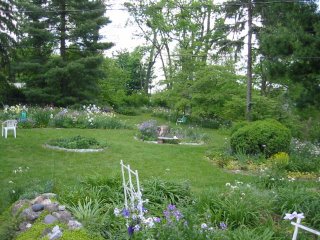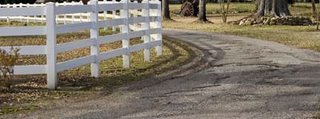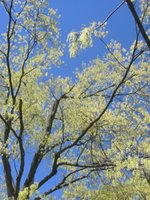History Of the Garden
 My friends thought I was crazy for buying this property in 1989. But you see, I grew up on a farm and I wanted a farm. Husband/Best Friend/Main Photographer mostly lived in towns – he wanted no part of a farm! Crocker Croft was a compromise.
My friends thought I was crazy for buying this property in 1989. But you see, I grew up on a farm and I wanted a farm. Husband/Best Friend/Main Photographer mostly lived in towns – he wanted no part of a farm! Crocker Croft was a compromise.I named our newly acquired home-place “Crocker Croft”, because it is a smallish property enclosed by the fences, trees and shrubbery of five other properties, one of which was a farm where horses sometimes looked over the fence at me.
Surveyors recorded the acreage as one acre; therefore one acre is recorded on the deed. It seems much more when we are weeding, and I think it actually is a little more; because surveying is done on a horizontal plane – and believe me, this is no flat horizontal plane!
Prior to suburban development, most of our back yard (back garden) was a limestone quarry, which left it with a huge hole and sheer limestone cliffs approximately sixty feet high. My next-door neighbor was living here at that time; she told me it was full of trees strung with large wild vines giving it a primeval appearance. She said the first owners of our house had a baby and although they had fenced the upper area near the house, they were terrified that little toddler would get over, under, or someway through that fence and fall into the abyss.
So, they hired a landscape company that delivered and put into place 600 loads of soil; landscaped the property; and planted pink and white flowering shrubs, trees, and perennials along the property lines on both sides, all the way from front to far back. That was in 1956. To this day, after all the storms and droughts, there is still evidence of those pink and white plantings. And, now we have a bowl effect in the former quarry - which I call the dell.
Then at some point in time, our friend Mary and her husband purchased the property. Mary was VERY energetic, and an avid gardener and compulsive planter for many years. As time went by, her husband died; then her own age and health conditions began to catch up with her, causing family to want her closer to them. At eighty-two years young, she was still climbing trees to prune them, and going strong. (I did mention she was very energetic, didn’t I?) But, she complied, and moved a large number of her plants out to the family’s farm where they all lived within shouting distance of one another.


Back here at Crocker Croft:
Chapter 2


Over the years, plants have frequently appeared that hadn’t been there before – they still do. At first I was puzzled, but now I just smile and consider them a sweet gift. Seeds of annuals and biennials appear to have slept in the detritus of mulches waiting for the right conditions to awaken. And, I have figured out that many must be new plants regenerated from bits of root inadvertently left in the earth when Mary moved her most cherished and beloved plants with her to the farm.
Mary was well known for her beautiful yard and flowers. She gave me an old newspaper clipping about this yard being open to the public for a tour, one day many years ago. There were photographs of the yard showing a young garden with few trees - and those were very small; it was totally different from the place we purchased. In 1989 there were numerous huge, really huge, trees everywhere. Where there were sun-loving flowers in the photographs, now there were only shade plants, so for a few years, I gardened in shade. Then came the storms.
As the storms (of all kinds - wind, rain, snow, and ice) visited us over the years, we lost more and more trees. Large trees broke and fell, or dropped parts, on top of the smaller understory trees and shrubs, crushing them and exposing them to the sun. Diseases and sunscald have taken their toll. Then there was the ice storm of 2003. (More about that in another post.)
Today, we have gone full circle. Now, we are back to growing sun-loving plants (some came back voluntarily), and are moving the blistered shade plants to more sheltered locations. Some structures have been built to produce more shade for them.
We’ve lived here nearly seventeen years, now, and I’ve made the garden more my own. There are reminders of Mary most everywhere I look; she is frequently in my thoughts, and my writing will have references to things she did or said. She must be about 100 years old now, and is no longer living on the farm. Things change. Conditions change. People change. And especially, gardens change –- constantly.
 OVER THE YEARS
OVER THE YEARSChapter 3 Husband/best friend gave me roses for our wedding anniversaries – one rose for each year of marriage. After 33 years it was getting expensive. We bought this place and he said, firmly, “Now, you can grow your own roses.” I’ll always remember: He not only gave me roses, he bought me a whole garden!
Moving here was an adventure, a whole new world. There were so many plants I didn’t recognize. Is it a weed or a keeper?! If it is a weed, what are its growth habits so that I may interrupt them and prevent it from multiplying! Is it an annual, biennial, or perennial?
The first three or four years, I spent a great amount of time with my nose in books - books about all kinds of shrubs, trees, perennials, annuals, hardy annuals, biennials, plus wildflowers, weeds, and grasses - trying to identify, studying, reading, learning - my library growing.
Slowly, I was able to identify and learn about most new-to-me resident plants. Totally perplexed by a couple, I took those to our County Agriculture Extension Office and the Horticulture Agent. It surely has been “a learning experience”.
Now, instead of books, I find myself at the computer reading for hours, and hours, about all kinds of plants all over the world.
It is a marvelous thing, this tool, this World Wide Web (www).
History Chapter 4

WHAT I LIKE ABOUT THE COLONY
So why did we buy Crocker Croft? As I wrote in a previous chapter, it was a compromise: I wanted country. He wanted city. This is where we landed.
To leave the rat race and turn into The Colony is a special joy. Immediately as one pulls through the old white fence the relaxing feeling of country peacefulness settles upon visitors and residents alike.
Rural, it is not. Though a wealth of trees and shrubs contribute sylvan cover - natural screening providing privacy for neighbor, from neighbor - summertime sounds float through the trees almost too close, their sources hidden. But for the voices, laughter, and soft music one would hardly know they are there... until wintertime.
When winter closes in, forcing retreat to warmth, the foliage lies on the ground in decaying amber sheets and the landscape seems to change almost overnight. Neighbors' houses and lights immerge. Electrical lights appear to be on terraces from the tall buildings downtown several miles away, stepping down to Traveler Road, down to upper Parker's Mill Road, then lower Parker's Mill Road, and really low in Chinquapin Cul-d-sac where the lights seem to be way down a hole. They are not too close - now that life has moved inside. When harsh elements threaten, it is comforting to see neighbors' lights, high and low, near and far; and comforting to know they are there.
The Colony was created with streets patterned after winding country roads. And with white board fences to sustain its connection to rural horse farms and the aura of the area. Once part of famous Calumet Farm, The Colony's historic ties have been apparent by a few old pear trees in neighbors' yards, remnants of Calumet's fruit orchard of years ago.
I've been told, when the neighborhood was started in the early 1950s, the developer laid out the streets, then had sugar maples planted along them on both sides even before construction on the houses began. Thanks to his foresight, The Colony has been beautiful in September and October. What a delicious experience, what joy to walk or drive along enveloped in beautiful, absolutely glowing warm colors; I go slowly; I don't want the trip to end. As much as I cherish that, I do believe my favorite time for the maples is March when they are in bloom with their lacy tassels of pale chartreuse. Such massive utter sheer beauty is indescribable.

Those curvy streets lined with mature sugar maples; the small parkways at their intersections; the colonial-style street lamps with underground lines reminiscent of old gas lamps casting soft warm glows; medium size houses of diverse styles with spacious yards; friendly neighbors; friendly walkers of all ages; and evidences of family life all create a sense of neighborhood.

It is that aura of country peacefulness that removes it from the maddening crowd. For the location of The Colony is surprisingly convenient to most places, partly due to its proximity to Bluegrass Field airport, and to two main transportation corridors: Man-o-War Boulevard and New Circle Road which makes the interstate highways seem nearer than they are.
Life is pleasant in The Colony with its feel of country, trees and wildlife; plus its convenience to such places as the Civic Center; The Hyatt Hotel; Lexington Green shopping mall; Turfland Mall; the neighborhood shopping center, Gardenside; Farmers' Market; Gratz Park; Carnegie Center; the Opera House; Main Library and its Cardinal Valley Branch; Kentucky Theater; Rupp Arena; The Springs Motel with traditional Kentucky dining room; plus there are fast food restaurants galore, almost anything one could want is near by. We are convenient to Red Mile racetrack for standard-bred horses; historic Keeneland racetrack for thoroughbred horses; and with easy access to the University of Kentucky, and its expansive medical center, via Red Mile Road and Virginia Avenue... Yet, we are far enough away from the commotion of daily life by pulling into the quiet "country" area called The Colony and leaving all that behind.
Now, if you will excuse me, I am headed out to my garden. I've read the best thing for a garden is the gardener's shadow.

Addendum:
News has reached me that Mary died early in March 2007. If she had lived until April, she would have been 100 years old. Her work and dedication to her flowers plus her kind, sharing spirit brought much happiness to many, many people. We miss her already.


<<Back to Home Page